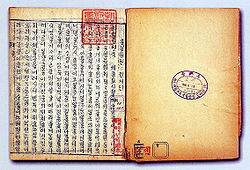Hangul
Hangeul (Korean: 한글) is the alphabet (or alphabetic syllabary) used for the Korean language.[1][2] It was created by Sejong the Great, the 4th King of the Joseon Dynasty in 1443. It is still being used now. When Hangeul was spreading, King Sejong published Hunminjeong'eum Haeryebon (훈민정음 해례본). It was chosen as the 'Memory of the World' by UNESCO in 1997.
In this book, the design ideas of Hangeul and information about its use were written down in detail. The book Hunminjeong'eum Haeryebon states the two design ideas of Hangeul. The first one is that the consonants of Hangeul look like vocal organs. The second one is that the vowels of Hangeul are based on Cheonji'in (천지인). Cheonji'in refers to the three elements of philosophy which are sky (천), earth (지) and human (인). Because of these ideas, Hangeul is well known for being easy to learn.
Although it was only used by the lower classes at first, Hangeul became the official writing script of Korea in the late 19th century. Today it is the most used writing system of both North Korea and South Korea. North Korea abolished the use of Hanja, and today North Koreans write only in Hangeul. In South Korea, people write mostly in Hangeul, but sometimes Hanja is still used.
Vowels
There are 21 letters for vowels in Hangul.
- 10 simple ones, ㅏㅓㅣㅑㅕ and ㅗㅜㅡㅛㅠ.
- 11 more complicated combinations: ㅐㅒㅔㅖ and ㅘㅙㅚㅝㅞㅟㅢ.
The vowels are transliterated into the Roman alphabet as follows:
| ㅏ | ㅓ | ㅣ | ㅑ | ㅕ | ㅗ | ㅜ | ㅡ | ㅛ | ㅠ | ㅐ | ㅒ | ㅔ | ㅖ | ㅘ | ㅙ | ㅚ | ㅝ | ㅞ | ㅟ | ㅢ |
| a | eo | i | ya | yeo | o | u | eu | yo | yu | ae | yae | e | ye | wa | wae | oe | wo | we | wi | eui |
Those with two small lines are pronounced with an extra "y" first.
Consonants
There are 14 simple consonants: ㄱㄴㄷㄹㅁㅂㅅㅇㅈㅊㅋㅌㅍㅎ. Some of them can also be written next to each other at the end of syllables.
| letter | sound | |
|---|---|---|
| before vowel |
after vowel | |
| ㄱ | g | k |
| ㄴ | n | |
| ㄷ | d | t |
| ㄹ | r | l |
| ㅁ | m | |
| ㅂ | b | p |
| ㅅ | s | t |
| ㅇ | - | ng |
| ㅈ | j | t |
| ㅊ | ch | t |
| ㅋ | k | |
| ㅌ | t | |
| ㅍ | p | |
| ㅎ | h | t |
| ㄲ | kk | k |
| ㄸ | tt | t |
| ㅃ | pp | p |
| ㅆ | ss | t |
| ㅉ | jj | t |
The consonants the Korean language uses written in Latin letters are: B, D, G, H, J, K, L, M, N, P, R, S, T, W, Y.
Blocks
The consonants and vowels are combined into blocks of syllables. A syllable means one vowel and a few consonants, like "han" and "geul".
The blocks look like these examples: 서울 한글 평양
Examples
| Seoul 서울 | Hangeul 한글 | Pyongyang 평양 | ||||||||||||||||||
| ㅅ | ㅓ | ㅇ | ㅜ | ㄹ | ㅎ | ㅏ | ㄴ | ㄱ | ㅡ | ㄹ | ㅍ | ㅕ | ㅇ | ㅇ | ㅑ | ㅇ | ||||
| s | eo | - | u | l | h | a | n | g | eu | l | p | yeo | ng | - | ya | ng | ||||
+{{{1}}}−{{{2}}}
Hangul Media
First page of the Hunminjeongeum, which formally introduced Hangul
A copy of the landmark novel Hong Gildong jeon
Tongnip sinmun, the first modern Korean newspaper and the first to use pure Hangul
Cover of a revision of the Unified Hangul Orthography
A sample of Hangul writing using the South Korean orthography. Letters are arranged in syllable blocks, spacing is used, and most punctuation used is similar to that of the West, with the exception of the tilde (~) for number ranges.
The South Korean dubeolsik keyboard layout
Korean Braille encodes the letters of Hangul
References
- ↑ Kolers, Paul A. (1979). Processing of Visible Language. Merald E. Wrolstad, Herman Bouma. Boston, MA: Springer US. pp. 67–82. ISBN 978-1-4684-0994-9. OCLC 851828930.
- ↑ Pae, Hye K. (1 January 2011). "Is Korean a syllabic alphabet or an alphabetic syllabary". Writing Systems Research. 3 (2): 103–115. doi:10.1093/wsr/wsr002. ISSN 1758-6801. Retrieved 17 October 2017.
Other websites
 Media related to Hangul at Wikimedia Commons
Media related to Hangul at Wikimedia Commons










